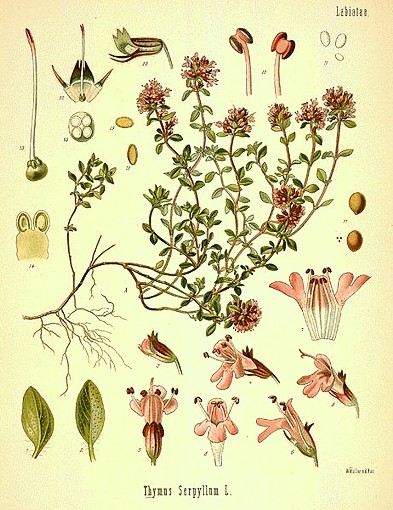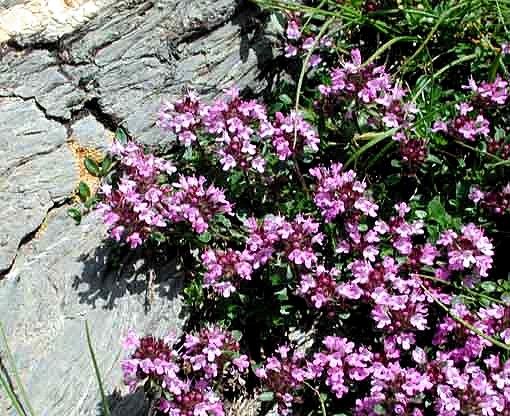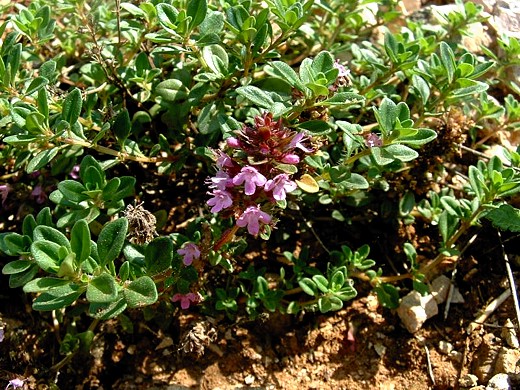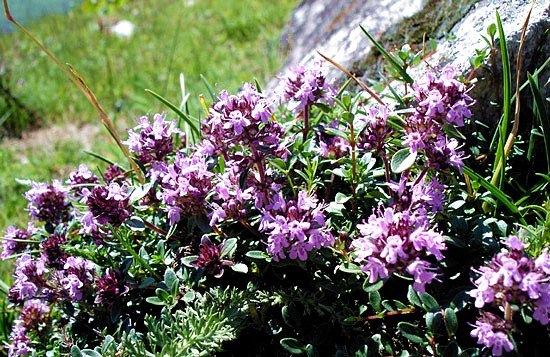Lessico
Serpillo
- Sermolino
Thymum serpyllum

Thymum deriva dal greco thýmon che significa timo,
la pianta, a sua volta derivato dal verbo thýø = infuriare, agitarsi,
smaniare, forse per la decantata azione afrodisiaca e antimelanconica. Ambedue
i sostantivi sono neutri. Dioscoride![]() per indicare il timo usa thýmos, maschile,
ma per lo più questo vocabolo significa escrescenza, oppure quell'organo
linfatico situato alla base del collo nel mediastino anteriore. Per Plinio
per indicare il timo usa thýmos, maschile,
ma per lo più questo vocabolo significa escrescenza, oppure quell'organo
linfatico situato alla base del collo nel mediastino anteriore. Per Plinio![]() thymus, maschile, significa verruca, che è
un'escrescenza. Giustamente Pierandrea Mattioli
thymus, maschile, significa verruca, che è
un'escrescenza. Giustamente Pierandrea Mattioli![]() traduce thýmos di Dioscoride con il neutro thymum.
In base a ciò si emenda Thymus serpyllum in Thymum serpyllum,
ma solo nel nostro testo, lasciando intatti i testi derivati da fonti del web.
Serpyllum, neutro, in quanto è un aggettivo sostantivizzato, deriva
dall'aggettivo greco hérpyllos a sua voilta da hérpø =
strisciare, corrispondente al latino serpere = serpeggiare, strisciare,
come fanno i serpenti.
traduce thýmos di Dioscoride con il neutro thymum.
In base a ciò si emenda Thymus serpyllum in Thymum serpyllum,
ma solo nel nostro testo, lasciando intatti i testi derivati da fonti del web.
Serpyllum, neutro, in quanto è un aggettivo sostantivizzato, deriva
dall'aggettivo greco hérpyllos a sua voilta da hérpø =
strisciare, corrispondente al latino serpere = serpeggiare, strisciare,
come fanno i serpenti.
Il Thymum serpyllum è una pianta della famiglia Labiate comune nei luoghi submontani incolti, fino al livello alpino, dell'Europa temperata. È un piccolo suffrutice con foglie piccole, ovali od oblunghe, glabre o pelose, e fiori rosei o porporini, in spicastri apicali. Tutta la pianta è molto aromatica per il contenuto in timolo, usato in medicina come disinfettante della pelle e delle mucose e nella preparazione di aromi artificiali, e in altri oli essenziali.
Thymus serpyllum

Caratteristiche - Piccolo arbusto con radici sottili verticali; il fusto, in parte strisciante sul suolo, produce a ogni nodo radici avventizie da cui partono i fusti verticali o sdraiato-ascendenti alti fino a 20 cm; i fusti sono quadrangolari in sezione e abbondantemente pubescenti, la superficie è spesso soffusa di rosso. Le foglie, opposte, sono distanti nei rami fertili e avvicinate in quelli sterili; variano da lineari a ovali a subrotonde, comunque sono sempre un po' spatolate, hanno cioè la massima larghezza verso l'apice che è arrotondato, alla base si restringono in un corto picciolo spesso provvisto di lunghi peli; la superficie è punteggiata da ghiandole. I fiori sono raggruppati in pseudoverticilli all'apice dei fusticini; il calice è tubulare, cilindrico-campanulato e termina in due labbra: il superiore è rivolto verso l'alto e diviso in tre piccoli lobi, l'inferiore è formato da due sottili appendici incurvate; la corolla è anch'essa tubulare e bilabiata con il labbro superiore intero e l'inferiore diviso in tre lobi ovali; il colore è normalmente rosato, talvolta può essere biancastro o porporino. Il frutto è formato da quattro acheni ovoidali di colore bruno posti al fondo del calice persistente.
Habitat - Frequente nell'area mediterranea, in Italia predilige i terreni incolti e solatii, ma cresce anche al margine delle boscaglie, lungo i pendii, nei prati come tra le rocce e i terreni poveri. Diffuso dalla pianura alla montagna.0-2200 m. Aprile agosto
Proprietà farmaceutiche - Il timo serpillo assomiglia alquanto nell'aspetto e nelle proprietà al timo volgare. Da questo si differenzia per le foglie distese e per la mancanza, nella pagina inferiore delle stesse, di quell'aspetto cotonoso tipico del timo. Pianta aromatica, assai usata in cucina, è ricca di proprietà in particolare antisettiche, antispasmodiche, depurative, espettoranti, balsamiche e digestive. È utile nei casi di tosse, catarri bronchiali, asma. Ha proprietà stimolati dell'apparato digestivo per cui è consigliato nei casi di astenia, stati di debolezza e affaticamento. (Droga usata: sommità fiorite). Dal serpillo si estrae un'essenza simile a quella estratta dal timo, che ha un'azione vermicida e balsamica.
Uso in cucina - In cucina viene ampiamente impiegato come pianta aromatica per insaporire carni e pesci.
Nota - Assieme alla menta e alla salvia, il timo è una delle erbe aromatiche più apprezzate nella cucina europea. Se seccato e accuratamente conservato, mantiene il suo aroma per anni. Le foglie contengono timolo, un olio aromatico che ha qualità antisettiche. Tra i resti dei fuochi dell'Età della pietra sono state trovate tracce di varie specie di timo, che i nostri antenati bruciavano per godere del loro profumo e per tenere lontani gli insetti. La flora italiana comprende circa dieci specie di Thymus, molto simili tra loro.
www.fungoceva.it

Thymus serpyllum, known by the common names of Wild Thyme or Creeping Thyme is a species of thyme native to most of Europe and North Africa. It is a low, usually prostrate subshrub growing to 2 cm tall with creeping stems up to 10 cm long, with oval evergreen leaves 3-8 mm long. The strongly scented flowers are either lilac, pink-purple, magenta, or a rare white, all 4-6 mm long and produced in clusters. The hardy plant tolerates some pedestrian traffic and produces odors ranging from heavily herbal to lightly lemon, depending on the plant. It is a source of oil of Serpolet by distillation, and is used as an aphrodisiac in herbal medicine. It is used as a spice for different meat dishes, cabbage or green salads, and vegetable dishes containing zucchini and eggplant. The dried leaves are used for a herbal tea throughout Europe and the United States.
It is an important nectar source plant for honeybees as well as the large blue butterfly which feeds exclusively on wild thyme. All thyme species are nectar sources, but wild thyme covers large areas of droughty, rocky soils in southern Europe. Croatia, Greece, North Africa, Malta, the Berkshire Mountains and Catskill Mountains of the northeastern United States, and New Zealand are especially famous for wild thyme honey.
Wild Thyme
The Wild Thyme is indigenous to the greater part of the dry land of Europe, though is a great deal less abundant than the Common Thyme so widely cultivated. It is found up to a certain height on the Alps, on high plateaux, and in valleys, along ditches and roads, on rocks, in barren and dry soil, and also in damp clay soil destitute of chalk. It is seen in old stony, abandoned fields, dried-up lawns and on clearings. In England it is found chiefly on heaths and in mountainous situations, and is also often cultivated as a border in gardens or on rockeries and sunny banks. It was a great favourite of Francis Bacon, who in giving us his plan for the perfect garden, directs that alleys should be planted with fragrant flowers: 'burnet, wild thyme and watermints, which perfume the air most delightfully being trodden upon and crushed,' so that you may 'have pleasure when you walk or tread.'
The herb wherever it grows wild denotes a pure atmosphere, and was thought to enliven the spirits by the fragrance which it diffuses into the air around. The Romans gave Thyme as a sovereign remedy to melancholy persons.
Wild Thyme is a perennial, more thickset than the Garden Thyme, though subject to many varieties, according to the surroundings in which it grows. In its most natural state, when found on dry exposed downs, it is small and procumbent, often forming dense cushions; when growing among furze or other plants which afford it shelter, it runs up a slender stalk to a foot or more in height, which gives it a totally different appearance. The specific name, serpyllum, is derived from a Greek word meaning to creep, and has been given it from its usually procumbent and trailing habit.
--- Description --- The root is woody and fibrous, the stems numerous, hard, branched, procumbent, rising from 4 inches to 1 foot high, ordinarily reddish-brown in colour. The bright green oval leaves 1/8 inch broad, tapering below into very short foot-stalks, are smooth and beset with numerous small glands. They are fringed with hairs towards the base and have the veins prominent on the under surfaces. Their margins are entire and not recurved as in Garden Thyme. As with all other members of the important order Labiatae, to which the Thymes belong, the leaves are set in pairs on the stem. The plant flowers from the end of May or early June to the beginning of autumn, the flowers, which are very similar to those of the Garden Thyme, being purplish and in whorls at the top of the stems.
Bees are especially fond of the Thyme blossoms, from which they extract much honey. Spenser speaks of the 'bees-alluring time,' and everyone is familiar with Shakespeare's the 'bank whereon the wild thyme blows,' the abode of the queen of the Fairies. It was looked upon as one of the fairies' flowers, tufts of Thyme forming one of their favourite playgrounds.
In some parts it was a custom for girls to wear sprigs of Thyme, with mint and lavender, to bring them sweethearts! Thyme has also been associated with death. It is one of the fragrant flowers planted on graves (in Wales, particularly), and the Order of Oddfellows still carry sprigs of Thyme at funerals and throw them into the grave of a dead brother. An old tradition says that Thyme was one of the herbs that formed the fragrant bed of the Virgin Mary. Wild Thyme is the badge of the Drummond clan.
--- Cultivation --- Wild Thyme will grow on any soil, but prefers light, sandy or gravel ground exposed to the sun. Propagate by seeds, cuttings, or division of roots. Care must be taken to weed. Manure with farmyard manure in autumn or winter and nitrates in spring. Cut when in full flower, in July and August, and dry in the same manner as Common Thyme. It is much picked in France, chiefly in the fields of the Aisne, for the extraction of its essential oil.
--- Constituents --- When distilled, 100 kilos (about 225 lb.) of dried material yield 150 grams of essence (about 5 or 6 OZ.). It is a yellow liquid, with a weaker scent than that of oil of Thyme extracted from T. vulgaris, and is called oil of Serpolet. It contains 30 to 70 per cent of phenols: Thymol, Carvacrol, etc. It is made into an artificial oil, together with the oil of Common Thyme. In perfumery, oil of Serpolet is chiefly used for soap. The flowering tops, macerated for 24 hours or so in salt and water, are made into a perfumed water.
--- Medicinal Action and Uses --- In medicine, Wild Thyme or Serpolet has the same properties as Common Thyme, but to an inferior degree. It is aromatic, antiseptic, stimulant, antispasmodic, diuretic and emmenagogue. The infusion is used for chest maladies and for weak digestion, being a good remedy for flatulence, and favourable results have been obtained in convulsive coughs, especially in whooping cough, catarrh and sore throat. The infusion, prepared with 1 OZ. of the dried herb to a pint of boiling water, is usually sweetened with sugar or honey and made demulcent by linseed or acacia. It is given in doses of 1 or more tablespoonfuls several times daily.
The infusion is also useful in cases of drunkenness, and Culpepper recommends it as a certain remedy taken on going to bed for 'that troublesome complaint the nightmare,' and says: 'if you make a vinegar of the herb as vinegar of roses is made and annoint the head with it, it presently stops the pains thereof. It is very good to be given either in phrenzy or lethargy.'
Wild Thyme Tea, either drunk by itself or mixed with other plants such as rosemary, etc., is an excellent remedy for headache and other nervous affections. Formerly several preparations of this plant were kept in shops, and a distilled spirit and water, which were both very fragrant.
http://botanical.com

Le serpolet (Thymus serpyllum) ou thym serpolet est un sous-arbrisseau de la famille des Lamiacées appartenant au genre Thymus. C'est une plante aromatique basse, qui ne dépasse pas 10 cm de hauteur, mais s'étend sur 50cm de largeur ; elle est tapissante, aux tiges radicantes aux nœuds, aux très petites feuilles opposées ovales ou lancéolées, aux courtes hampes florales dressées. De juin à septembre, son feuillage aromatique vert à reflets pourprés sous le soleil disparaît littéralement sous une nuée de petites fleurs bleues groupées en capitules terminaux, plus carminés dans la variété coccineus. Après la floraison, (juin à octobre) viennent les fruits formés de quatre petits akènes.
C'est une plante des zones de broussailles, des prés secs, des rochers, des dunes, jusqu'à 3000 m d'altitude. Ne les plantez pas dans une terre trop riche car c'est dans les sols maigres et secs qu'ils donnent le meilleur d'eux-mêmes et répandent alors des senteurs de garrigue. Pour la culture en pot, utilisez une terre poreuse. Comme ils détestent les terres humides, installez-les dans un endroit surélevé par rapport à l'allée, afin que l'eau s'écoule. Si vous devez les tailler, faites-le après la floraison. Quant à leur multiplication, elle se fait par division des touffes au printemps ou par bouturage estival.
Le serpolet est antiseptique et il a des propriétés anti-virales. Il est aussi stomachique, expectorant et antispasmodique. En aromate ou en infusion, c'est un désinfectant des voies digestives souvent utilisé associé au romarin et à la sauge. Il soulage les digestions difficiles. L'infusion de serpolet s'utilisait en bain de bouche en cas d'inflammation des gencives et en gargarisme en cas d'irritation de la gorge ou d'angine. Mais surtout le serpolet ou des préparations contenant les divers thyms s'utilisent en fumigation pour traiter les rhinites et les sinusites.